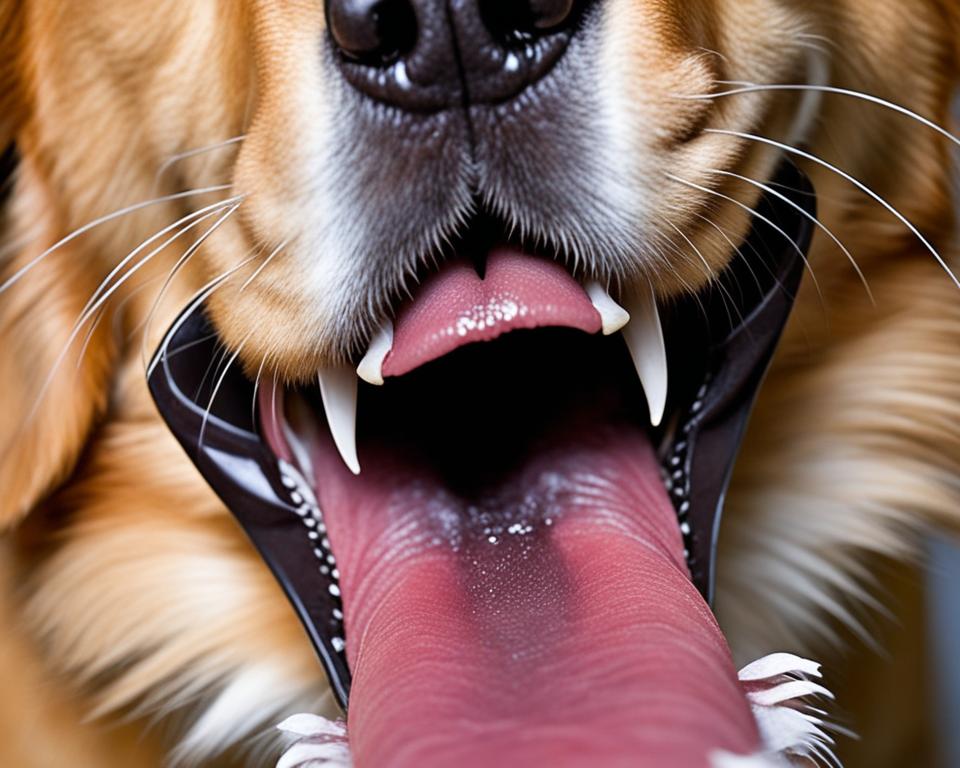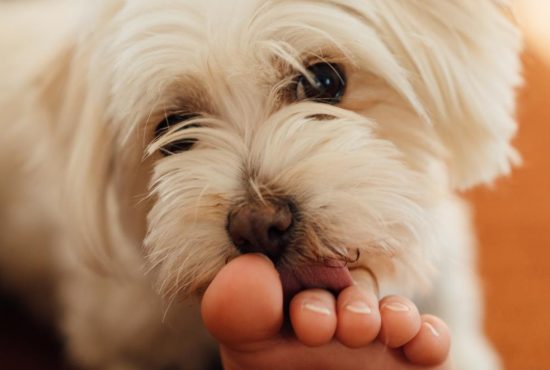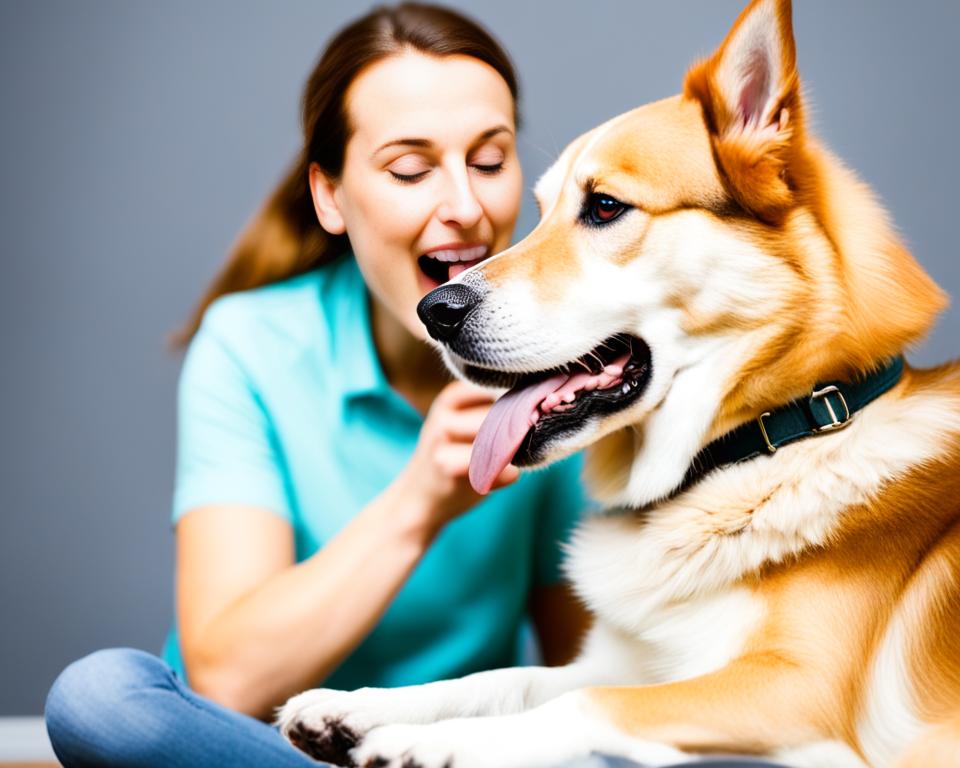Why Do Dogs Lick Your Feet? Reasons Explained
Uncover the intriguing reasons behind your dog’s behavior with our expert insights on why dogs lick your feet. Decode your pet’s affectionate gestures!

Did you know that dogs have a staggering 200 million scent receptors in their noses, compared to our mere 5 million? It’s no wonder they’re so fascinated by the world around them, including our feet!
When dogs lick your feet, it can be both endearing and perplexing. In this section, we will delve into the reasons behind why do dogs lick your feet. Understanding why dogs lick feet is essential in deciphering their communication and building a stronger bond with these lovable companions.
Understanding Canine Behavior and Foot-Licking Tendencies

Dogs have their unique ways of communicating with us, and one such behavior that often leaves us intrigued is when they lick our feet. In this section, we will dive deeper into understanding why dogs engage in foot-licking behavior and what it signifies in terms of their communication.
When your dog licks your feet, it is important to recognize that it is their way of expressing affection and bonding with you. Dogs have a natural inclination to lick to show affection and seek attention. It is their way of demonstrating their love and loyalty toward their human companions.
However, foot-licking behavior can also have other underlying meanings. Dogs may lick your feet as a form of greeting, signaling submission, or seeking comfort. It can also be a way for them to explore and gather information about their environment. By observing their body language and context, you can better decipher the specific message behind their licks.
The role of pheromones and your unique scent
One fascinating aspect of canine behavior and foot-licking tendencies is the role of pheromones and your unique scent. Dogs have an incredibly keen sense of smell, and licking your feet allows them to gather important information about you.
Pheromones, which are chemical substances produced by animals, including humans, play a crucial role in communication. Dogs can detect and respond to these pheromones through their sense of smell, and your feet carry a significant amount of your unique scent. When dogs lick your feet, they are not only expressing affection but also gathering information and reinforcing the bond between you.
Understanding this aspect of canine behavior can help you appreciate the complexity of a dog’s lick as a form of communication. Building awareness of their specific body language, the context of licking, and the presence of pheromones can deepen your connection and strengthen the bond with your four-legged companion.
| Canine Behavior | Foot-Licking Tendencies |
|---|---|
| Expression of affection | Seeking attention and bonding |
| Greeting ritual | Signaling submission |
| Exploring the environment | Gathering information through scent |
Are Dog Licks a Form of Canine Communication?
When your dog licks you, it’s not just a display of affection. In fact, licking is one of the ways dogs communicate with their human counterparts. Understanding the messages behind those licks can help you strengthen your bond with your furry friend.
Interpreting dog’s licks can provide valuable insights into their emotions and intentions. Dogs use licking as a way to express various emotions, such as love, trust, and even anxiety. For example, when your dog licks your hand gently, it’s often a sign of affection and a way to show their bond with you. On the other hand, frantic or excessive licking may indicate stress or anxiety.
It’s also important to pay attention to the context of the lick. If your dog licks you after you return home from a long day, it can be a form of greeting and an expression of excitement to see you. Similarly, if your dog licks your face, it can be a way of seeking attention and affection.
Licking as a greeting ritual
Licking is also a natural part of a dog’s social behavior. In their canine world, dogs use licking as a greeting ritual to establish social bonds and communicate their friendly intentions. When two dogs meet, they often engage in mutual sniffing and gentle licking as a way to communicate their peaceful intentions and establish a positive rapport.
As a dog’s owner, you become part of their social circle, and they extend this greeting ritual to you through licking. It’s their way of acknowledging your presence, showing trust, and fostering social connection.
By understanding the different meanings behind your dog’s licks, you can reciprocate their communication effectively and build a deeper understanding and bond with your furry companion.
Unpacking the Sensory Experience: Why Does Dog Licking Feet Feel Good?
It’s a common sensation that many dog owners can relate to – the sensory experience of dog licking feet. But have you ever wondered why this behavior feels so good? In this section, we will explore the scientific reasons behind the pleasurable sensations associated with dogs licking feet.
The Science of Pleasant Sensations
When a dog licks your feet, it can trigger a range of pleasurable sensations. This is because the act of licking releases endorphins, which are natural chemicals in the brain that promote feelings of happiness and well-being. As your dog’s tongue makes contact with your skin, it stimulates various nerve endings, creating a sensory experience that can be both soothing and enjoyable.
Additionally, the rhythmic motion of the licking can have a calming effect, similar to a gentle massage. The repetitive action combined with the soft texture of a dog’s tongue can provide a comforting sensation, helping you relax and unwind.

Endorphins Released During Licking
One key contributor to the pleasurable sensations experienced during dog licking is the release of endorphins. Endorphins are neurotransmitters that act as natural painkillers and mood enhancers. They can create a sense of euphoria and contribute to the overall feelings of comfort and well-being.
When your dog licks your feet, the mechanical action of their tongue stimulates the release of endorphins in both you and your furry companion. This chemical interaction can create a positive feedback loop, reinforcing the pleasurable sensations for both you and your dog.
It’s worth noting that the sensory experience and pleasure associated with dog licking can vary from person to person. Some individuals may find it exceptionally pleasurable, while others may not experience the same level of enjoyment. Each person’s sensory and emotional responses can be influenced by various factors, including personal preferences and past experiences.
Why do dogs lick your feet?
There are various reasons why dogs are compelled to lick feet. This behavior can stem from their innate affectionate nature, curiosity, or even a way to seek attention from their human companions. Dogs see licking as a form of communication, expressing their emotions and bonding with you.
When your dog licks your feet, it may be their way of showing affection and love. Licking is a natural behavior for dogs, and it is often associated with their desire to connect and feel close to you. Dogs have a strong sense of smell and can detect your unique scent on your feet, which can further reinforce their bond with you.
Understanding your dog’s unique licking patterns is crucial in interpreting their behaviors and needs. Some dogs may prefer to lick feet as a way to seek attention or gain comfort, while others may do it out of curiosity or a display of submission. By observing their specific licking patterns, you can develop a better understanding of your dog’s individual needs and preferences.

The Health and Hygiene Factors in Dog Licking
While dog licking can be a sign of affection, it’s important to consider the health and hygiene factors associated with this behavior. Letting your dog lick your feet can pose certain risks that you need to be aware of. Infections and allergies are potential health concerns that can arise from dog licking.
When dogs lick your feet, they may transfer bacteria or allergens from their mouths onto your skin. This can lead to skin irritations, infections, or allergic reactions, especially if you have sensitive skin or existing skin conditions. Therefore, it’s crucial to understand the potential risks and take necessary precautions.
To manage the health risks of dog licking, proper hygiene practices are essential. Regularly wash your feet with mild soap and water to minimize the buildup of bacteria and allergens. Dry your feet thoroughly after washing them, as moisture can create an environment conducive to bacterial growth.
It’s also advisable to avoid letting your dog lick open wounds or areas of broken skin, as this increases the risk of infection. If you notice any signs of irritation or infection after your dog has licked your feet, it’s important to consult a healthcare professional for proper evaluation and treatment.

Risks associated with letting your dog lick your feet
Letting your dog lick your feet can expose you to various health risks. Here are some potential risks:
- 1. Infections: Dog saliva can carry bacteria, such as Staphylococcus aureus, which may cause skin infections.
- 2. Allergic reactions: If you have allergies, your dog’s saliva can trigger an allergic response, leading to itching, redness, or swelling.
- 3. Dermatitis: Constant licking can disrupt the natural balance of oils on your skin, leading to dryness, itchiness, and inflammation.
- 4. Parasites: Dogs can carry parasites, such as fleas and ticks, in their saliva, which can be transferred to your feet through licking.
- 5. Zoonotic diseases: Some diseases that can be transmitted from dogs to humans, such as leptospirosis and ringworm, can be transmitted through contact with their saliva.
Ensuring good hygiene to manage licking
To manage dog licking and maintain good hygiene, consider the following tips:
- Clean your dog’s paws: Regularly wipe your dog’s paws with pet-safe wipes or a damp cloth to remove any dirt, allergens, or potential contaminants.
- Practice good pet grooming: Regularly brush your dog’s coat to remove loose hair and debris. This can reduce the amount of dirt or allergens they may transfer to your feet through licking.
- Teach your dog boundaries: Train your dog to understand and respect boundaries, including not licking your feet excessively or when you have open wounds.
- Redirect their behavior: Instead of allowing your dog to lick your feet, offer them alternative ways to show affection, such as petting, cuddling, or playing together.
- Consult your veterinarian: If you’re concerned about your dog’s licking behavior or have specific health concerns, consult your veterinarian for professional advice tailored to your dog’s needs.
By prioritizing good hygiene practices and managing your dog’s licking behavior responsibly, you can maintain a healthy environment for both you and your pet.
Managing and Redirecting Unwanted Foot-Licking Behavior
If you want to manage or redirect your dog’s unwanted foot-licking behavior, there are effective training techniques you can use. Implementing these strategies can help your dog reduce or redirect their licking tendencies and promote more desirable behaviors.
Effective training techniques
When it comes to managing dog-licking behavior, consistency and positive reinforcement play key roles. Here are a few techniques that can be effective in curbing unwanted licking:
- When you notice your dog’s foot-licking, gently redirect its attention to a more appropriate activity, such as playing with a toy or engaging in a training session.
- Reward your dog for not licking your feet by offering treats, praise, and affection. This will reinforce the desired behavior and discourage unwanted licking.
- If your dog licks your feet as a means of seeking attention, it’s essential to ignore the behavior. You can discourage this behavior over time by withholding attention during licking episodes.
- Gradually expose your dog to situations that trigger foot-licking tendencies and reward them for remaining calm and refraining from licking. This will help reduce their sensitivity to those triggers and encourage alternative behaviors.
Using toys and distractions to curb licking
In addition to implementing training techniques, using toys and distractions can be helpful in curbing excessive licking behaviors. Providing your dog with appropriate chew toys and puzzles can redirect their focus and provide mental stimulation, reducing the urge to lick. Interactive toys, such as treat-dispensing toys, can be especially effective in keeping your dog engaged and occupied.
| Technique | Benefits |
|---|---|
| Redirect attention | – Draws focus away from foot licking – Promotes alternative, desirable behaviors |
| Positive reinforcement | – Reinforces desired behavior – Encourages obedience |
| Ignore the behavior | – Discourages attention-seeking licking – Teaches dogs that licking does not result in desired outcome |
| Desensitization | – Reduces sensitivity to triggers – Encourages alternative behaviors |
By employing these training techniques, along with providing appropriate toys and distractions, you can effectively manage and redirect your dog’s unwanted foot-licking behavior. Remember to be patient and consistent in your training efforts, and seek professional guidance if needed.
Insights from Dog Trainers and Behaviorists on Licking
When it comes to understanding your dog’s licking behavior, professional dog trainers and behaviorists can provide valuable insights. These experts have extensive knowledge and experience in working with dogs and can offer guidance on addressing licking behaviors in a safe and effective manner.
Dog trainers emphasize the importance of differentiating between normal and excessive licking. They explain that while occasional licking is a natural behavior for dogs, excessive licking can indicate underlying issues such as anxiety, stress, or discomfort. By observing your dog’s overall behavior and considering any changes in their environment or routine, trainers can help you identify the root cause of excessive licking and develop appropriate strategies to address it.
Behaviorists, on the other hand, approach licking behavior from a psychological perspective. They analyze the context in which the licking occurs and the triggers that may be influencing the behavior. By understanding the function of licking in your dog’s communication repertoire, behaviorists can guide you on how to best respond to their licking gestures.
FAQs on dogs lick your feet
What does it signify when a dog licks your feet?
When a dog licks your feet, it can be a sign of affection, submission, or a way to communicate their needs. It can also be a way for them to mark their territory or investigate scents on your feet.
Why does dog licking feet feel good?
Dog licking can feel pleasurable due to the release of endorphins during the licking process. These endorphins can create positive sensations and contribute to the enjoyable experience.
Why do dogs lick feet so much?
Dogs may lick feet excessively due to anxiety, stress, or to seek attention. It’s essential to understand the underlying reasons behind their excessive licking behavior and address any potential underlying issues.
Are dog licks kisses?
While some people consider dog licks as kisses, it’s important to note that dogs lick for various reasons and it may not always be a display of affection. Dog licks can also serve as a way for them to gather information about their environment or communicate their needs.





